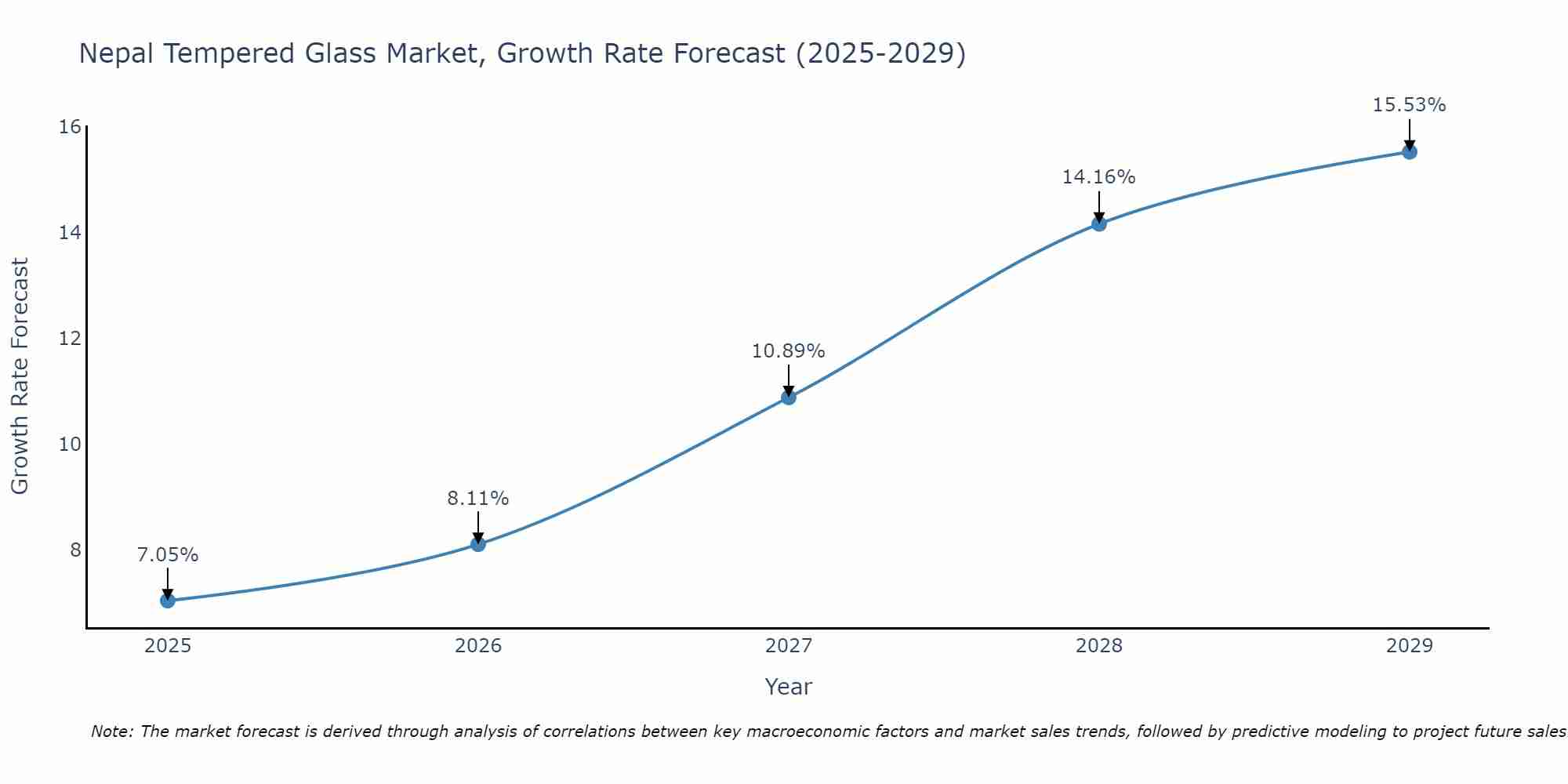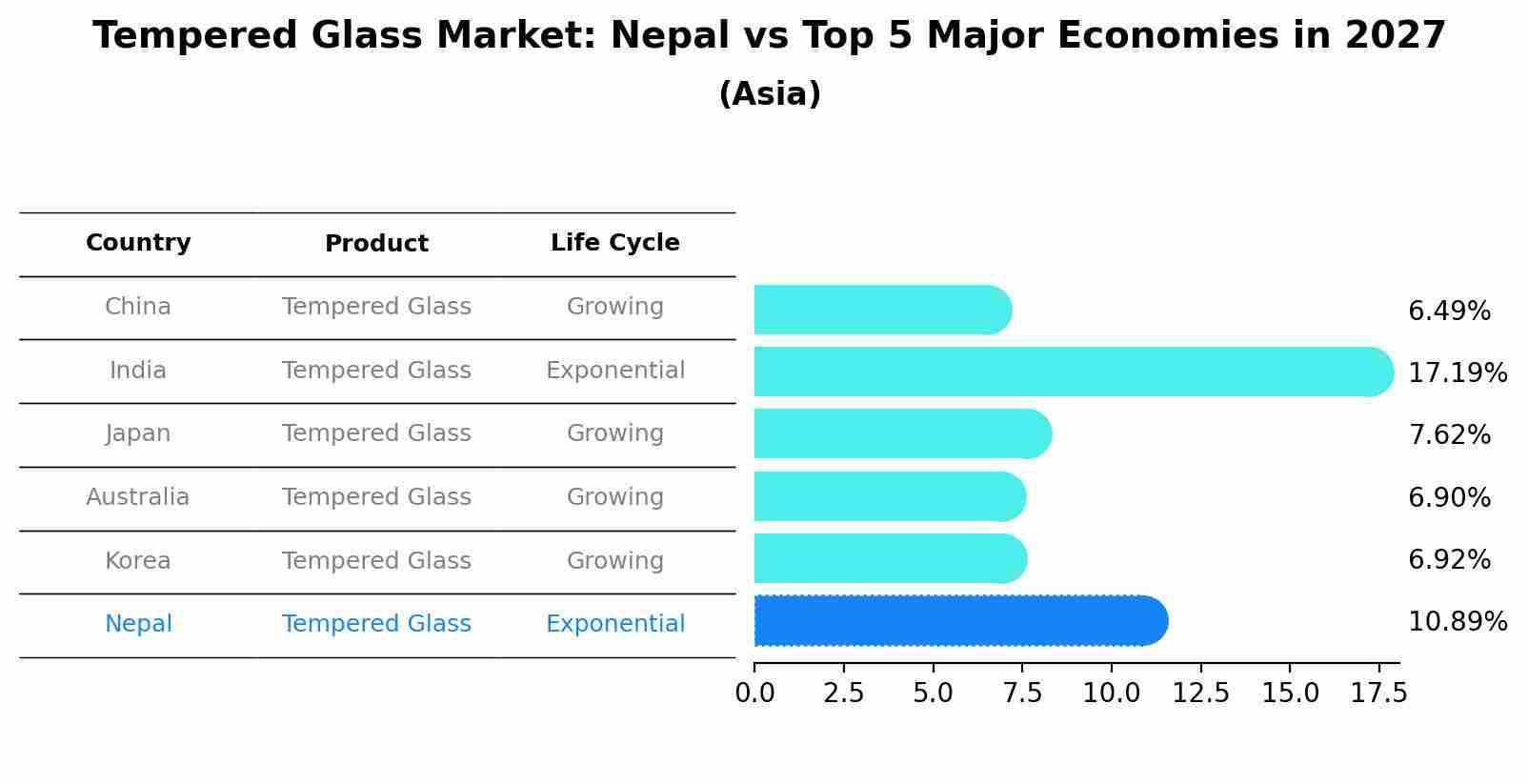Nepal Tempered Glass Market (2025-2031) Outlook | Growth, Revenue, Forecast, Analysis, Trends, Value, Companies, Industry, Share & Size
| Product Code: ETC215328 | Publication Date: May 2022 | Updated Date: Aug 2025 | Product Type: Market Research Report | |
| Publisher: 6Wresearch | Author: Summon Dutta | No. of Pages: 60 | No. of Figures: 40 | No. of Tables: 7 |
Nepal Tempered Glass Market Size Growth Rate
The Nepal Tempered Glass Market is poised for steady growth rate improvements from 2025 to 2029. From 7.05% in 2025, the growth rate steadily ascends to 15.53% in 2029.

Tempered Glass Market: Nepal vs Top 5 Major Economies in 2027 (Asia)
By 2027, Nepal's Tempered Glass market is forecasted to achieve a high growth rate of 10.89%, with China leading the Asia region, followed by India, Japan, Australia and South Korea.

Nepal Tempered Glass Market Overview
The Nepal tempered glass market is experiencing steady growth driven by increasing adoption in construction, automotive, and electronics sectors. As consumers prioritize safety and durability, tempered glass is becoming a popular choice for applications such as windows, doors, facades, and automotive windshields. The market is also benefiting from the country`s rapid urbanization and infrastructure development projects. Key players in the Nepal tempered glass market include local manufacturers as well as international companies expanding their presence in the region. Factors such as rising disposable income, changing consumer preferences, and stricter safety regulations are expected to further drive the demand for tempered glass in Nepal, presenting opportunities for market growth and innovation in the coming years.
Nepal Tempered Glass Market Trends
The Nepal tempered glass market is experiencing steady growth driven by increasing demand in the construction and automotive sectors. With the rise in infrastructure development projects, there is a growing need for durable and safe building materials, leading to a higher adoption of tempered glass for windows, facades, and interior decorations. In the automotive industry, the emphasis on vehicle safety and aesthetics has also fueled the demand for tempered glass in windshields and windows. Additionally, the growing awareness among consumers about the benefits of tempered glass such as enhanced strength, safety, and thermal resistance is further driving market growth. Companies in the Nepal tempered glass market are focusing on product innovations, such as anti-reflective coatings and customizable designs, to cater to the evolving consumer preferences and sustain their competitive edge in the market.
Nepal Tempered Glass Market Challenges
The Nepal Tempered Glass Market faces several challenges, including intense competition from local and international manufacturers, fluctuating raw material prices, and quality control issues. The market is also impacted by the availability of skilled labor for glass production and the lack of standardized regulations governing the industry. Additionally, the market is sensitive to changes in consumer preferences and economic conditions, leading to demand fluctuations. Infrastructure limitations and logistical challenges in transportation and distribution further add complexity to the market landscape. Overall, addressing these challenges will be crucial for companies operating in the Nepal Tempered Glass Market to maintain competitiveness and sustain growth in the long term.
Nepal Tempered Glass Market Investment Opportunities
The Nepal tempered glass market presents promising investment opportunities due to the growing demand for safety glass in construction, automotive, and electronics sectors. With increasing awareness about the benefits of tempered glass such as enhanced strength, thermal resistance, and safety features, the market is expected to witness significant growth. Investing in local tempered glass manufacturing companies or establishing a distribution network for imported tempered glass products can be lucrative strategies. Additionally, offering value-added services like customization and installation services can help attract customers. As the construction and automotive industries continue to expand in Nepal, investing in the tempered glass market holds potential for long-term profitability and market share growth.
Nepal Tempered Glass Market Government Policy
The Nepal government has implemented various policies to regulate the tempered glass market in the country. These policies focus on ensuring product quality and safety standards are met by manufacturers and importers. The government has set specific guidelines for the production, import, and sale of tempered glass to protect consumers from potential hazards. Additionally, there are regulations in place to monitor pricing practices and prevent anti-competitive behavior in the market. Companies operating in the Nepal tempered glass market are required to adhere to these government policies to maintain compliance and contribute to a fair and transparent marketplace.
Nepal Tempered Glass Market Future Outlook
The future outlook for the Nepal Tempered Glass Market appears to be promising, driven by the growing construction and infrastructure development projects in the country. The increasing demand for tempered glass in various applications such as residential and commercial buildings, automotive, and electronics is expected to fuel market growth. Additionally, the rising focus on safety and durability features in construction and automotive industries is likely to further boost the adoption of tempered glass products. Technological advancements in glass manufacturing processes, coupled with the growing awareness regarding the benefits of tempered glass, are anticipated to drive market expansion in the coming years. However, factors such as fluctuating raw material prices and intense market competition may pose challenges to market players in maintaining profitability and market share.
Key Highlights of the Report:
- Nepal Tempered Glass Market Outlook
- Market Size of Nepal Tempered Glass Market, 2024
- Forecast of Nepal Tempered Glass Market, 2031
- Historical Data and Forecast of Nepal Tempered Glass Revenues & Volume for the Period 2021 - 2031
- Nepal Tempered Glass Market Trend Evolution
- Nepal Tempered Glass Market Drivers and Challenges
- Nepal Tempered Glass Price Trends
- Nepal Tempered Glass Porter's Five Forces
- Nepal Tempered Glass Industry Life Cycle
- Historical Data and Forecast of Nepal Tempered Glass Market Revenues & Volume By End-user Industry for the Period 2021 - 2031
- Historical Data and Forecast of Nepal Tempered Glass Market Revenues & Volume By Automotive for the Period 2021 - 2031
- Historical Data and Forecast of Nepal Tempered Glass Market Revenues & Volume By Construction for the Period 2021 - 2031
- Historical Data and Forecast of Nepal Tempered Glass Market Revenues & Volume By Electronics for the Period 2021 - 2031
- Historical Data and Forecast of Nepal Tempered Glass Market Revenues & Volume By Other End-user Industries for the Period 2021 - 2031
- Nepal Tempered Glass Import Export Trade Statistics
- Market Opportunity Assessment By End-user Industry
- Nepal Tempered Glass Top Companies Market Share
- Nepal Tempered Glass Competitive Benchmarking By Technical and Operational Parameters
- Nepal Tempered Glass Company Profiles
- Nepal Tempered Glass Key Strategic Recommendations
Frequently Asked Questions About the Market Study (FAQs):
1 Executive Summary |
2 Introduction |
2.1 Key Highlights of the Report |
2.2 Report Description |
2.3 Market Scope & Segmentation |
2.4 Research Methodology |
2.5 Assumptions |
3 Nepal Tempered Glass Market Overview |
3.1 Nepal Country Macro Economic Indicators |
3.2 Nepal Tempered Glass Market Revenues & Volume, 2021 & 2031F |
3.3 Nepal Tempered Glass Market - Industry Life Cycle |
3.4 Nepal Tempered Glass Market - Porter's Five Forces |
3.5 Nepal Tempered Glass Market Revenues & Volume Share, By End-user Industry, 2021 & 2031F |
4 Nepal Tempered Glass Market Dynamics |
4.1 Impact Analysis |
4.2 Market Drivers |
4.2.1 Increasing construction activities and infrastructure development in Nepal |
4.2.2 Growing demand for modern architectural designs and aesthetics |
4.2.3 Rising awareness about the benefits of tempered glass in terms of safety and durability |
4.3 Market Restraints |
4.3.1 High initial cost of tempered glass compared to traditional glass options |
4.3.2 Limited availability of skilled labor for installation and maintenance of tempered glass products |
5 Nepal Tempered Glass Market Trends |
6 Nepal Tempered Glass Market, By Types |
6.1 Nepal Tempered Glass Market, By End-user Industry |
6.1.1 Overview and Analysis |
6.1.2 Nepal Tempered Glass Market Revenues & Volume, By End-user Industry, 2021 - 2031F |
6.1.3 Nepal Tempered Glass Market Revenues & Volume, By Automotive, 2021 - 2031F |
6.1.4 Nepal Tempered Glass Market Revenues & Volume, By Construction, 2021 - 2031F |
6.1.5 Nepal Tempered Glass Market Revenues & Volume, By Electronics, 2021 - 2031F |
6.1.6 Nepal Tempered Glass Market Revenues & Volume, By Other End-user Industries, 2021 - 2031F |
7 Nepal Tempered Glass Market Import-Export Trade Statistics |
7.1 Nepal Tempered Glass Market Export to Major Countries |
7.2 Nepal Tempered Glass Market Imports from Major Countries |
8 Nepal Tempered Glass Market Key Performance Indicators |
8.1 Number of building permits issued in Nepal |
8.2 Adoption rate of tempered glass in new construction projects |
8.3 Number of training programs conducted for skilled labor in tempered glass installation and maintenance |
9 Nepal Tempered Glass Market - Opportunity Assessment |
9.1 Nepal Tempered Glass Market Opportunity Assessment, By End-user Industry, 2021 & 2031F |
10 Nepal Tempered Glass Market - Competitive Landscape |
10.1 Nepal Tempered Glass Market Revenue Share, By Companies, 2024 |
10.2 Nepal Tempered Glass Market Competitive Benchmarking, By Operating and Technical Parameters |
11 Company Profiles |
12 Recommendations |
13 Disclaimer |
- Single User License$ 1,995
- Department License$ 2,400
- Site License$ 3,120
- Global License$ 3,795
Search
Thought Leadership and Analyst Meet
Our Clients
Related Reports
- Canada Oil and Gas Market (2026-2032) | Share, Segmentation, Value, Industry, Trends, Forecast, Analysis, Size & Revenue, Growth, Competitive Landscape, Outlook, Companies
- Germany Breakfast Food Market (2026-2032) | Industry, Share, Growth, Size, Companies, Value, Analysis, Revenue, Trends, Forecast & Outlook
- Australia Briquette Market (2025-2031) | Growth, Size, Revenue, Forecast, Analysis, Trends, Value, Share, Industry & Companies
- Vietnam System Integrator Market (2025-2031) | Size, Companies, Analysis, Industry, Value, Forecast, Growth, Trends, Revenue & Share
- ASEAN and Thailand Brain Health Supplements Market (2025-2031) | Strategy, Consumer Insights, Analysis, Investment Trends, Opportunities, Growth, Size, Share, Industry, Revenue, Segments, Value, Segmentation, Supply, Forecast, Restraints, Outlook, Competition, Drivers, Trends, Demand, Pricing Analysis, Competitive, Strategic Insights, Companies, Challenges
- ASEAN Bearings Market (2025-2031) | Strategy, Consumer Insights, Analysis, Investment Trends, Opportunities, Growth, Size, Share, Industry, Revenue, Segments, Value, Segmentation, Supply, Forecast, Restraints, Outlook, Competition, Drivers, Trends, Demand, Pricing Analysis, Competitive, Strategic Insights, Companies, Challenges
- Europe Flooring Market (2025-2031) | Outlook, Share, Industry, Trends, Forecast, Companies, Revenue, Size, Analysis, Growth & Value
- Saudi Arabia Manlift Market (2025-2031) | Outlook, Size, Growth, Trends, Companies, Industry, Revenue, Value, Share, Forecast & Analysis
- Uganda Excavator, Crane, and Wheel Loaders Market (2025-2031) | Strategy, Consumer Insights, Analysis, Investment Trends, Opportunities, Growth, Size, Share, Industry, Revenue, Segments, Value, Segmentation, Supply, Forecast, Restraints, Outlook, Competition, Drivers, Trends, Demand, Pricing Analysis, Competitive, Strategic Insights, Companies, Challenges
- Rwanda Excavator, Crane, and Wheel Loaders Market (2025-2031) | Strategy, Consumer Insights, Analysis, Investment Trends, Opportunities, Growth, Size, Share, Industry, Revenue, Segments, Value, Segmentation, Supply, Forecast, Restraints, Outlook, Competition, Drivers, Trends, Demand, Pricing Analysis, Competitive, Strategic Insights, Companies, Challenges
Industry Events and Analyst Meet
Whitepaper
- Middle East & Africa Commercial Security Market Click here to view more.
- Middle East & Africa Fire Safety Systems & Equipment Market Click here to view more.
- GCC Drone Market Click here to view more.
- Middle East Lighting Fixture Market Click here to view more.
- GCC Physical & Perimeter Security Market Click here to view more.
6WResearch In News
- Doha a strategic location for EV manufacturing hub: IPA Qatar
- Demand for luxury TVs surging in the GCC, says Samsung
- Empowering Growth: The Thriving Journey of Bangladesh’s Cable Industry
- Demand for luxury TVs surging in the GCC, says Samsung
- Video call with a traditional healer? Once unthinkable, it’s now common in South Africa
- Intelligent Buildings To Smooth GCC’s Path To Net Zero


















